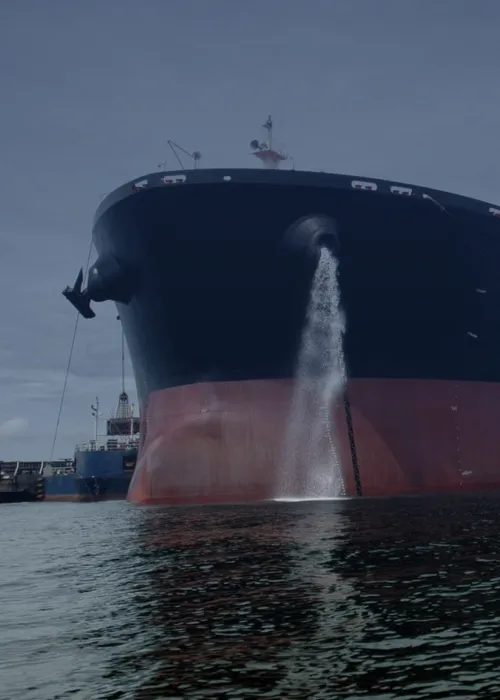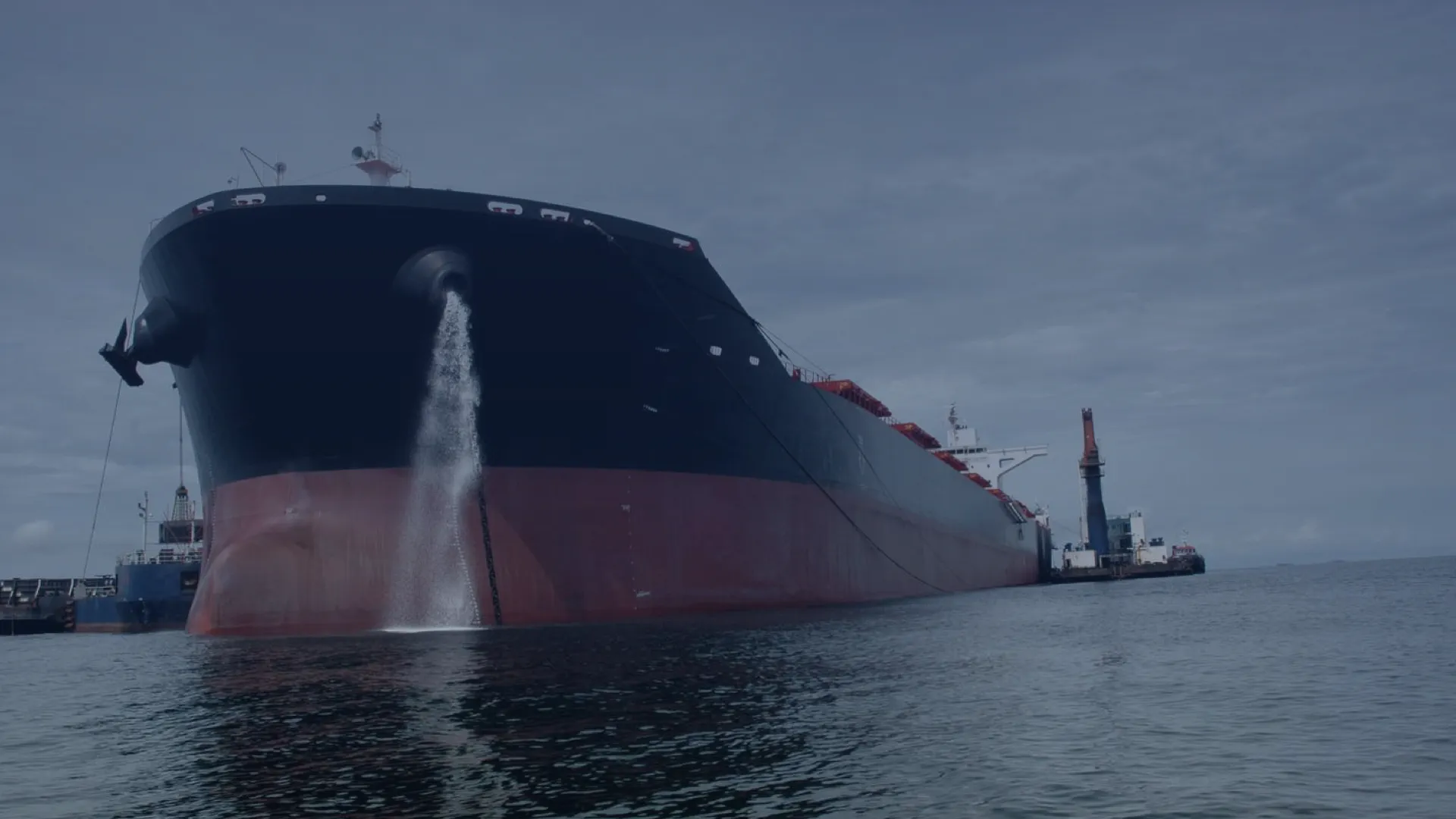
Ballast Water Treatment System (BWTS)
Discover the UV-based ballast water treatment system from our selected partner.

Introduction
A ballast water treatment system (BWTS), also known as a Ballast Water Management System (BWMS), removes, neutralizes, or kills harmful aquatic organisms such as zooplankton, algae, and bacteria from ballast water to prevent the spread of invasive species.
Traditional methods such as electrochlorination (EC) use chemicals, which can produce toxic byproducts.
A UV-based ballast water treatment system offers a more environmentally friendly alternative by using UV light without chemicals, making it safer for marine ecosystems.
Advantages of a UV-Based BWTS
A UV-based system offers significant advantages over chemical methods such as electrochlorination, especially in ballast water treatment in fresh, brackish, and saltwater. First and foremost, UV technology enhances onboard safety by completely eliminating the risks of toxic chlorine production and explosive hydrogen gas, thereby significantly increasing the safety of the crew.
Furthermore, UV treatment is environmentally friendly, as no disinfection by-products (DBPs) are generated and there is no need to manage Total Residual Oxidants (TRO). This not only contributes to the protection of the marine ecosystem but also reduces operational costs.
Finally, the use of UV systems results in direct cost savings for ship owners, as no chemical handling or storage is required. This makes management simpler and more efficient.
How Does a UV-Based Ballast Water Treatment System Work?
A UV-based ballast water treatment system operates in three key steps.
In the first step, pre-filtration, the incoming ballast water is filtered to remove larger particles and organisms, such as sediments, algae, and plankton. This process increases the effectiveness of the subsequent UV treatment by minimizing interference.
Next, during the UV treatment phase, the filtered water is exposed to intense ultraviolet light. This UV light damages the DNA of microorganisms, rendering them inactive and unable to reproduce.
In the final step, discharge, the treated water is safely returned to the marine environment, free from harmful organisms or chemicals. This integrated process ensures that the ballast water meets international and national environmental standards and can be safely discharged without negatively impacting the ecosystem.
Flexibility and Scalability of BWTS Systems
UV purification systems are designed with flexibility in mind. For ships with a standard ballast water flow, one filter and one UV reactor are often sufficient. For ships with a larger ballast capacity, additional filters and UV reactors can be added to meet operational requirements. This makes the systems suitable for various ship types.
Maintenance of a UV-Based Ballast Water Treatment System
The effectiveness of a UV-based BWTS is highly dependent on the regular maintenance of essential components such as filters, UV reactors, and UV lamps.
Depending on the specific system, there are various cleaning options available. Some systems are equipped with advanced automatic cleaning mechanisms, including self-cleaning filters and UV lamps. These technologies prevent fouling and ensure that the system continues to function optimally without the need for manual intervention.
In other cases, manual cleaning may be necessary, which is a more thorough but time-consuming method to keep the components clean.
International Regulations for Ballast Water Treatment Systems
BWTS systems have been developed in response to international regulations from both the International Maritime Organization (IMO) and the United States Coast Guard (USCG). Both organizations have set strict standards to prevent the introduction of invasive species through ballast water.
IMO Ballast Water Management Convention: this convention, adopted in 2004 and in force since September 8, 2017, requires ships worldwide to manage and treat their ballast water before discharging it. The IMO sets strict requirements for the number of living organisms that may remain in ballast water after treatment.
USCG standards: the United States Coast Guard has had its own ballast water standards in place since 2012, which are often stricter than those of the IMO. Ships entering U.S. waters must comply with these standards. This has led to the development of advanced BWTS that meet both IMO and USCG requirements.
The UV-based ballast water treatment system (BWTS) we offer in collaboration with our partner is certified and type-approved according to both IMO and USCG standards.
Ballast Water Treatment System (BWTS)

A ballast water treatment system (BWTS), also known as a Ballast Water Management System (BWMS), removes, neutralizes, or kills harmful aquatic organisms such as zooplankton, algae, and bacteria from ballast water to prevent the spread of invasive species. Traditional methods such as electrochlorination (EC) use chemicals, which can produce toxic byproducts. A UV-based ballast water treatment system offers a more environmentally friendly alternative by using UV light without chemicals, making it safer for marine ecosystems. Discover more about the ultraviolet (UV)-based treatment system from our selected partner.
Advantages of a UV-Based BWTS
A UV-based system offers significant advantages over chemical methods such as electrochlorination, especially in ballast water treatment in fresh, brackish, and saltwater. First and foremost, UV technology enhances onboard safety by completely eliminating the risks of toxic chlorine production and explosive hydrogen gas, thereby significantly increasing the safety of the crew.
Furthermore, UV treatment is environmentally friendly, as no disinfection by-products (DBPs) are generated and there is no need to manage Total Residual Oxidants (TRO). This not only contributes to the protection of the marine ecosystem but also reduces operational costs.
Finally, the use of UV systems results in direct cost savings for ship owners, as no chemical handling or storage is required. This makes management simpler and more efficient.
How Does a UV-Based Ballast Water Treatment System Work?
A UV-based ballast water treatment system operates in three key steps.
In the first step, pre-filtration, the incoming ballast water is filtered to remove larger particles and organisms, such as sediments, algae, and plankton. This process increases the effectiveness of the subsequent UV treatment by minimizing interference.
Next, during the UV treatment phase, the filtered water is exposed to intense ultraviolet light. This UV light damages the DNA of microorganisms, rendering them inactive and unable to reproduce.
In the final step, discharge, the treated water is safely returned to the marine environment, free from harmful organisms or chemicals. This integrated process ensures that the ballast water meets international and national environmental standards and can be safely discharged without negatively impacting the ecosystem.
Flexibility and Scalability of BWTS Systems
UV purification systems are designed with flexibility in mind. For ships with a standard ballast water flow, one filter and one UV reactor are often sufficient. For ships with a larger ballast capacity, additional filters and UV reactors can be added to meet operational requirements. This makes the systems suitable for various ship types.
Maintenance of a UV-Based Ballast Water Treatment System
The effectiveness of a UV-based BWTS is highly dependent on the regular maintenance of essential components such as filters, UV reactors, and UV lamps.
Depending on the specific system, there are various cleaning options available. Some systems are equipped with advanced automatic cleaning mechanisms, including self-cleaning filters and UV lamps. These technologies prevent fouling and ensure that the system continues to function optimally without the need for manual intervention.
In other cases, manual cleaning may be necessary, which is a more thorough but time-consuming method to keep the components clean.
International Regulations for Ballast Water Treatment Systems
BWTS systems have been developed in response to international regulations from both the International Maritime Organization (IMO) and the United States Coast Guard (USCG). Both organizations have set strict standards to prevent the introduction of invasive species through ballast water.
IMO Ballast Water Management Convention: this convention, adopted in 2004 and in force since September 8, 2017, requires ships worldwide to manage and treat their ballast water before discharging it. The IMO sets strict requirements for the number of living organisms that may remain in ballast water after treatment.
USCG standards: the United States Coast Guard has had its own ballast water standards in place since 2012, which are often stricter than those of the IMO. Ships entering U.S. waters must comply with these standards. This has led to the development of advanced BWTS that meet both IMO and USCG requirements.
The UV-based ballast water treatment system (BWTS) we offer in collaboration with our partner is certified and type-approved according to both IMO and USCG standards.
More information about ballast water management can be found on the official Ballast Water Management page of the International Maritime Organization (IMO). Information on type approval for ballast water management according to USCG standards is available on the official United States Coast Guard Ballast Water Management Type Approval page.
Frequently Asked Questions
What is ballast water?
Ballast water is the water a ship takes in or discharges into ballast tanks to regulate trim, stability, and structural stress. This water, including suspended particles, helps stabilize the ship while sailing. Water used in other ship systems, such as sanitation, is not included in this definition.
How does ballast water affect the environment, the economy, and public health?
- Ecological Impact: ballast water can introduce invasive species that disrupt local ecosystems and reduce biodiversity. The Chinese mitten crab is an example of an invasive species spreading along the Dutch coast via ballast water.
- Economic Consequences: invasive species can reduce fishery populations and clog industrial water intakes, causing millions of euros in damage annually.
- Health Risks: ballast water can spread pathogens such as cholera and cause harmful algal blooms, posing a threat to public health.
For which types of ships is a UV-based BWTS suitable?
UV-based BWTS are ideal for ships with low to medium ballast capacity, such as container ships, cruise ships, ferries, and navy ships. This technology is less suitable for large tankers or ships operating in turbid water due to flow limitations.
On which ships does the Ballast Water Management Convention not apply?
The convention does not apply to ships without ballast tanks, ships that take in and discharge ballast water at the same location, or ships that do not engage in international voyages.
What alternative methods are there besides electrolysis (EC) and UV radiation for ballast water treatment?
There are various alternative methods available for ballast water treatment:
- Filtration and Sedimentation: mechanical removal of larger particles and organisms without the use of chemicals.
- Advanced Oxidation Processes (AOP): a combination of oxidizing agents such as UV light, ozone, and hydrogen peroxide to generate highly reactive hydroxyl radicals that effectively break down microorganisms.
- Electrochemical Treatment: inactivation of microorganisms by generating oxidants through electric current without adding extra chemicals.
- Deoxygenation: removal of oxygen from ballast water by injecting an inert gas, such as nitrogen, to suffocate aerobic organisms.
- Heat Treatment: heating ballast water using excess engine heat or separate heating systems to kill microorganisms.
- Ultrasonic Cavitation: applying high-frequency sound waves that create cavitation bubbles, damaging the cell structures of microorganisms.
- Magnetic Field Treatment: using magnetic fields to influence the properties of microorganisms; however, the effectiveness of this method is limited and not widely accepted.
- Pasteurization: utilizing residual engine heat to warm ballast water to moderate temperatures for a certain period, killing harmful organisms without using chemicals.
- Chemical Injection: directly injecting biocides or oxidizing agents into ballast water to eliminate organisms.
- Ozone Treatment: applying ozone, a strong oxidizing agent, to oxidize and destroy microorganisms.
